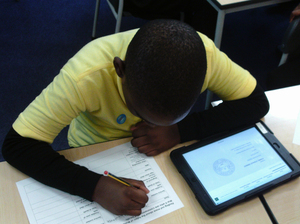- County name: London
- Group/School name: Kings Avenue School
- Age group: 5 - 11
- Group type: Year 4
The theme for learning for the year 4 classes at Kings Avenue School during the spring term is World War II. The school approached War Memorials Trust to request a visit which would help pupils find out more about war memorials in the local area as part of this topic. Our Learning Officer was happy to oblige and arranged to spend half a day with each of the classes towards the end of the spring term.
The sessions with both classes began with the pupils sharing some of the key facts that they had learnt as a result of their theme work to date. Pupils touched on how children were evacuated to the countryside and our Learning Officer explained that there is in fact a war memorial which remembers the people of Sudbury, Derbyshire, who looked after the Manchester evacuees during the Second World War.
The session moved on to provide pupils with an introduction to war memorials. They were asked to think about what a war memorial is before being shown some images to develop group discussions around this. Pupils identified that they were to remember people who fought and died in wars. They also noticed that war memorials come in lots of different designs (crosses, stone pillars, windows, buildings, statues) and are made of different materials. When pupils asked why this was the case our Learning Officer was able to explain it was because there were never any rules about what war memorials had to look like so communities could choose the design they felt was most appropriate.
A selection of photographs showing war memorials within a 3 mile radius of the school were then displayed and brief information about each one shared with the pupils who were familiar with many of the places mentioned including Kennington Park. Following this pupils were asked to consider how many war memorials there are in the UK and when these were created. Discussion then developed to help pupils understand why war memorials were created, particularly in the wake of the First World War. This understanding was consolidated by highlighting Commonwealth War Graves Commission (CWGC) Cemeteries abroad where men named on the Lambeth Municipal Officers Guild war memorial, who fought in both the First and Second World War, were buried. Countries included Israel and Palestine, Belgium and Norway. One pupil later commented
“I learnt that war memorials are local to homes so you don’t have to travel too far.”
The introduction to war memorials ended with pupils being asked to consider what problems they may face now especially as many approach their 100th anniversary. Answers included graffiti, people wanting to move them so they had more space, animals particularly birds pooing on them and problems caused by rain. Our Learning Officer was impressed with the wide range of answers given and problems considered.
The latter half of the session focused on finding out more about the people named on two local war memorials. The Lambeth Municipal Officers Guild war memorial in Lambeth Town Hall, Brixton and St Luke’s Church war memorial, Balham were selected as they both named those who had fought in the Second World War. Pupils really enjoyed using the CWGC’s Find War Dead database to identify who each person was and find the answers to questions they had including where are they buried, how old were they when they died and when did they die. Where there was information about relatives of the fallen, some pupils commented that some had not got married and this brought home that some of the men died when they were quite young.
The session concluded with the inscription on the gravestone of Sergeant Leonard Manchip being shared with the pupils which reads “God takes our loved ones from our homes but ever from our hearts.” It was felt that this summed up why war memorials were created.
Pupils understanding of war memorials and why we have them clearly grew through the activities they were engaged in. Our Learning Officer was delighted to be told by a pupil “that was a really interesting session” after they had carried out the name research. It is hoped that many of the pupils will now be more aware of war memorials around their local area.



